|
The Power Plant Electrical power starts at the power plant. In almost all cases, the power plant consists of a spinning electrical generator. Something has to spin that generator -- it might be a water wheel in a hydroelectric dam, a large diesel engine or a gas turbine. But in most cases, the thing spinning the generator is a steam turbine. The steam might be created by burning coal, oil or natural gas. Or the steam may come from a nuclear reactor like this one at the Shearon Harris nuclear power plant near Raleigh, North Carolina. 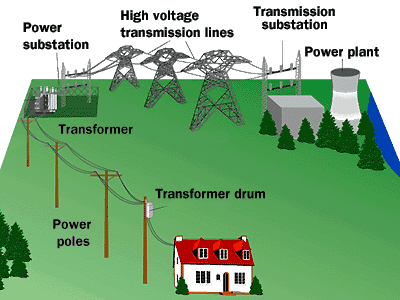 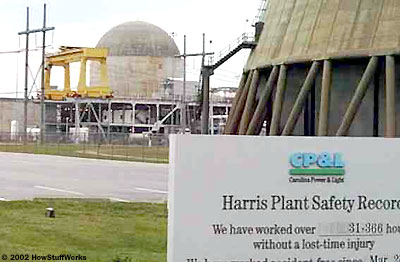 No matter what it is that spins the generator, commercial electrical generators of any size generate what is called 3-phase AC power. To understand 3-phase AC power, it is helpful to understand single-phase power first. 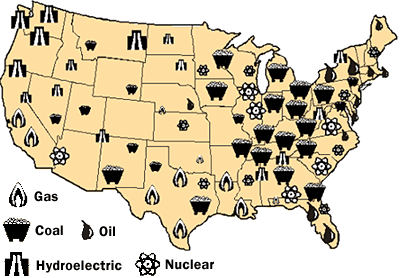
The Power Plant: Alternating Current Single-phase power is what you have in your house. You generally talk about household electrical service as single-phase, 120-volt AC service. If you use an oscilloscope and look at the power found at a normal wall-plate outlet in your house, what you will find is that the power at the wall plate looks like a sine wave, and that wave oscillates between -170 volts and 170 volts (the peaks are indeed at 170 volts; it is the effective (rms) voltage that is 120 volts). The rate of oscillation for the sine wave is 60 cycles per second. Oscillating power like this is generally referred to as AC, or alternating current. The alternative to AC is DC, or direct current. Batteries produce DC: A steady stream of electrons flows in one direction only, from the negative to the positive terminal of the battery. AC has at least three advantages over DC in a power distribution grid: 1. Large electrical generators happen to generate AC naturally, so conversion to DC would involve an extra step. 2. Transformers must have alternating current to operate, and we will see that the power distribution grid depends on transformers. 3. It is easy to convert AC to DC but expensive to convert DC to AC, so if you were going to pick one or the other AC would be the better choice. The power plant, therefore, produces AC. On the next page, you'll learn about the AC power produced at the power plant. Most notably, it is produced in three phases.v The Power Plant: Three-phase Power The power plant produces three different phases of AC power simultaneously, and the three phases are offset 120 degrees from each other. There are four wires coming out of every power plant: the three phases plus a neutral or ground common to all three. If you were to look at the three phases on a graph, they would look like this relative to ground: 
There is nothing magical about three-phase power. It is simply three single phases synchronized and offset by 120 degrees. Why three phases? Why not one or two or four? In 1-phase and 2-phase power, there are 120 moments per second when a sine wave is crossing zero volts. In 3-phase power, at any given moment one of the three phases is nearing a peak. High-power 3-phase motors (used in industrial applications) and things like 3-phase welding equipment therefore have even power output. Four phases would not significantly improve things but would add a fourth wire, so 3-phase is the natural settling point. And what about this "ground," as mentioned above? The power company essentially uses the earth as one of the wires in the power system. The earth is a pretty good conductor and it is huge, so it makes a good return path for electrons. (Car manufacturers do something similar; they use the metal body of the car as one of the wires in the car's electrical system and attach the negative pole of the battery to the car's body.) "Ground" in the power distribution grid is literally "the ground" that's all around you when you are walking outside. It is the dirt, rocks, groundwater, etc., of the earth. Transmission Substation The three-phase power leaves the generator and enters a transmission substation at the power plant. This substation uses large transformers to convert the generator's voltage (which is at the thousands of volts level) up to extremely high voltages for long-distance transmission on the transmission grid. You can see at the back several three-wire towers leaving the substation. Typical voltages for long distance transmission are in the range of 155,000 to 765,000 volts in order to reduce line losses. A typical maximum transmission distance is about 300 miles (483 km). High-voltage transmission lines are quite obvious when you see them. They are normally made of huge steel towers like this: All power towers like this have three wires for the three phases. Many towers, like the ones shown above, have extra wires running along the tops of the towers. These are ground wires and are there primarily in an attempt to attract lightning. The Distribution Grid For power to be useful in a home or business, it comes off the transmission grid and is stepped-down to the distribution grid. This may happen in several phases. The place where the conversion from "transmission" to "distribution" occurs is in a power substation. A power substation typically does two or three things: * It has transformers that step transmission voltages (in the tens or hundreds of thousands of volts range) down to distribution voltages (typically less than 10,000 volts). * It has a "bus" that can split the distribution power off in multiple directions. * It often has circuit breakers and switches so that the substation can be disconnected from the transmission grid or separate distribution lines can be disconnected from the substation when necessary. 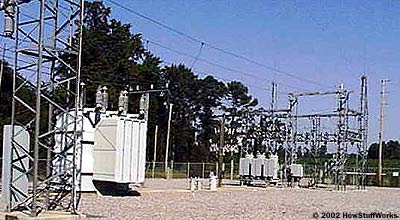 A typical small substation The box in the foreground is a large transformer. To its left (and out of the frame but shown in the next shot) are the incoming power from the transmission grid and a set of switches for the incoming power. Toward the right is a distribution bus plus three voltage regulators. 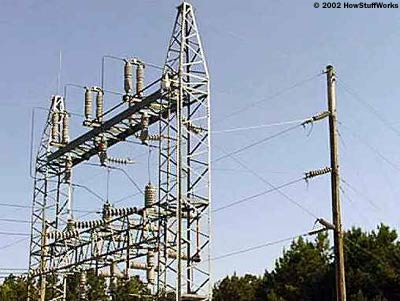
The transmission lines entering the substation and passing through the switch tower 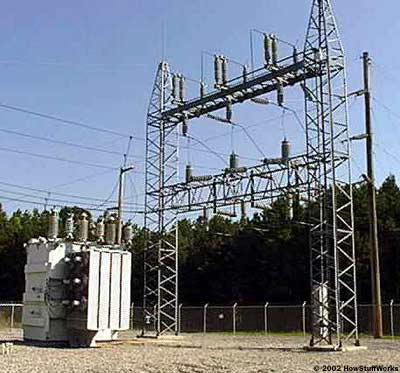 The switch tower and the main transformer Now the distribution bus comes into the picture. Distribution Bus The power goes from the transformer to the distribution bus: 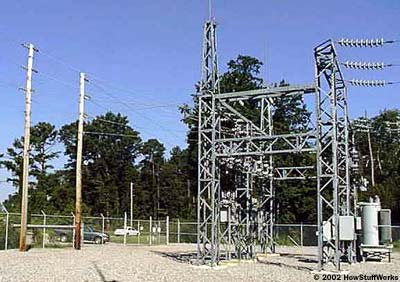 In this case, the bus distributes power to two separate sets of distribution lines at two different voltages. The smaller transformers attached to the bus are stepping the power down to standard line voltage (usually 7,200 volts) for one set of lines, while power leaves in the other direction at the higher voltage of the main transformer. The power leaves this substation in two sets of three wires, each headed down the road in a different direction: 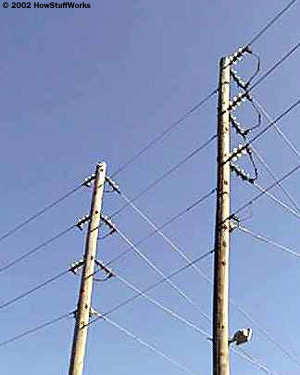
The wires between these two poles are "guy wires" for support. They carry no current. The next time you are driving down the road, you can look at the power lines in a completely different light. In the typical scene pictured on the right, the three wires at the top of the poles are the three wires for the 3-phase power. The fourth wire lower on the poles is the ground wire. In some cases there will be additional wires, typically phone or cable TV lines riding on the same poles. As mentioned above, this particular substation produces two different voltages. The wires at the higher voltage need to be stepped down again, which will often happen at another substation or in small transformers somewhere down the line. For example, you will often see a large green box (perhaps 6 feet/1.8 meters on a side) near the entrance to a subdivision. It is performing the step-down function for the subdivision. Regulator Bank You will also find regulator banks located along the line, either underground or in the air. They regulate the voltage on the line to prevent undervoltage and overvoltage conditions. 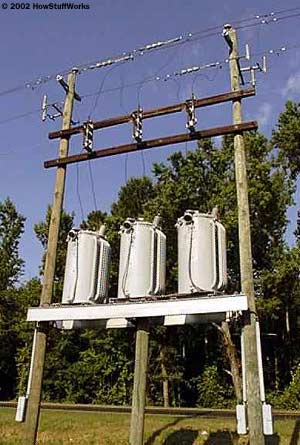 A typical regulator bank Up toward the top are three switches that allow this regulator bank to be disconnected for maintenance when necessary: 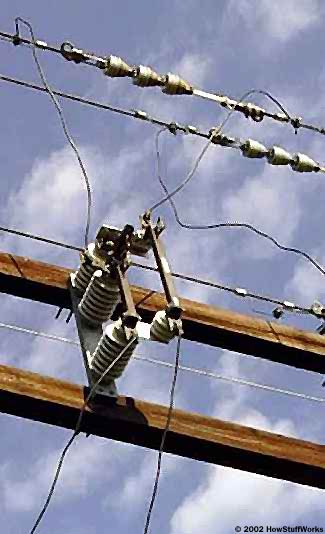
At this point, we have typical line voltage at something like 7,200 volts running through the neighborhood on three wires (with a fourth ground wire lower on the pole): 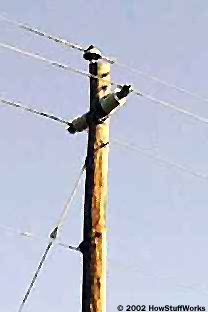
Taps A house needs only one of the three phases, so typically you will see three wires running down a main road, and taps for one or two of the phases running off on side streets. Pictured below is a 3-phase to 2-phase tap, with the two phases running off to the right: 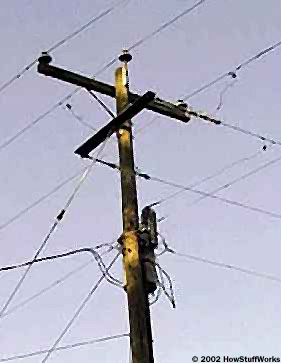
Here is a 2-phase to 1-phase tap, with the single phase running out to the right: 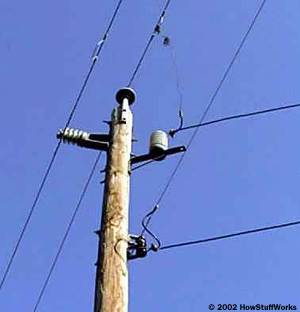
At the House And finally we are down to the wire that brings power to your house! Past a typical house runs a set of poles with one phase of power (at 7,200 volts) and a ground wire (although sometimes there will be two or three phases on the pole, depending on where the house is located in the distribution grid). At each house, there is a transformer drum attached to the pole, like this: 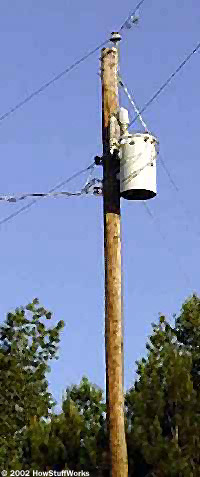
In many suburban neighborhoods, the distribution lines are underground and there are green transformer boxes at every house or two. Here is some detail on what is going on at the pole: 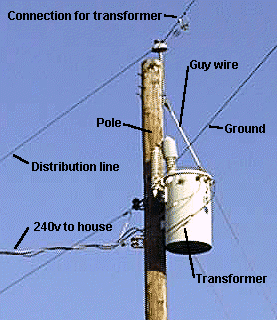
The transformer's job is to reduce the 7,200 volts down to the 240 volts that makes up normal household electrical service. Let's look at this pole one more time, from the bottom, to see what is going on: 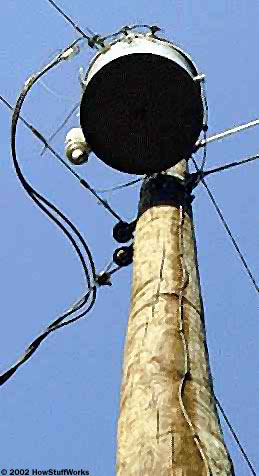
There are two things to notice in this picture: * There is a bare wire running down the pole. This is a grounding wire. Every utility pole on the planet has one. If you ever watch the power company install a new pole, you will see that the end of that bare wire is stapled in a coil to the base of the pole and therefore is in direct contact with the earth, running 6 to 10 feet (1.8 to 3 m) underground. It is a good, solid ground connection. If you examine a pole carefully, you will see that the ground wire running between poles (and often the guy wires) are attached to this direct connection to ground. * There are two wires running out of the transformer and three wires running to the house. The two from the transformer are insulated, and the third one is bare. The bare wire is the ground wire. The two insulated wires each carry 120 volts, but they are 180 degrees out of phase so the difference between them is 240 volts. This arrangement allows a homeowner to use both 120-volt and 240-volt appliances. The transformer is wired in this sort of configuration: 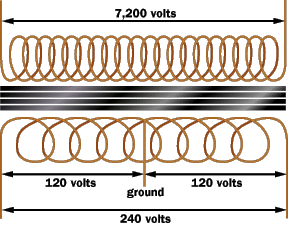 The 240 volts enters your house through a typical watt-hour meter like this one: 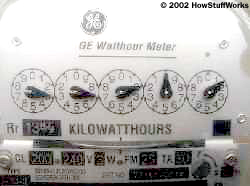 The meter lets the power company charge you for putting up all of these wires. Safety Devices: Fuses Fuses and circuit breakers are safety devices. Let's say that you did not have fuses or circuit breakers in your house and something "went wrong." What could possibly go wrong? Here are some examples: * A fan motor burns out a bearing, seizes, overheats and melts, causing a direct connection between power and ground. * A wire comes loose in a lamp and directly connects power to ground. * A mouse chews through the insulation in a wire and directly connects power to ground. * Someone accidentally vacuums up a lamp wire with the vacuum cleaner, cutting it in the process and directly connecting power to ground. * A person is hanging a picture in the living room and the nail used for said picture happens to puncture a power line in the wall, directly connecting power to ground. When a 120-volt power line connects directly to ground, its goal in life is to pump as much electricity as possible through the connection. Either the device or the wire in the wall will burst into flames in such a situation. (The wire in the wall will get hot like the element in an electric oven gets hot, which is to say very hot!). A fuse is a simple device designed to overheat and burn out extremely rapidly in such a situation. In a fuse, a thin piece of foil or wire quickly vaporizes when an overload of current runs through it. This kills the power to the wire immediately, protecting it from overheating. Fuses must be replaced each time they burn out. A circuit breaker uses the heat from an overload to trip a switch, and circuit breakers are therefore resettable. The power then enters the home through a typical circuit breaker panel like the one above. 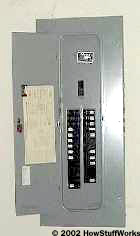
Safety Devices: Circuit Breakers Inside the circuit breaker panel you can see the two primary wires from the transformer entering the main circuit breaker at the top. The main breaker lets you cut power to the entire panel when necessary. Within this overall setup, all of the wires for the different outlets and lights in the house each have a separate circuit breaker or fuse: 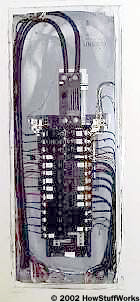
If the circuit breaker is on, then power flows through the wire in the wall and makes its way eventually to its final destination, the outlet. 

http://science.howstuffworks.com/environmental/energy/power12.htm http://science.howstuffworks.com/environmental/energy/power1.htm http://www.energy.gov/ |
